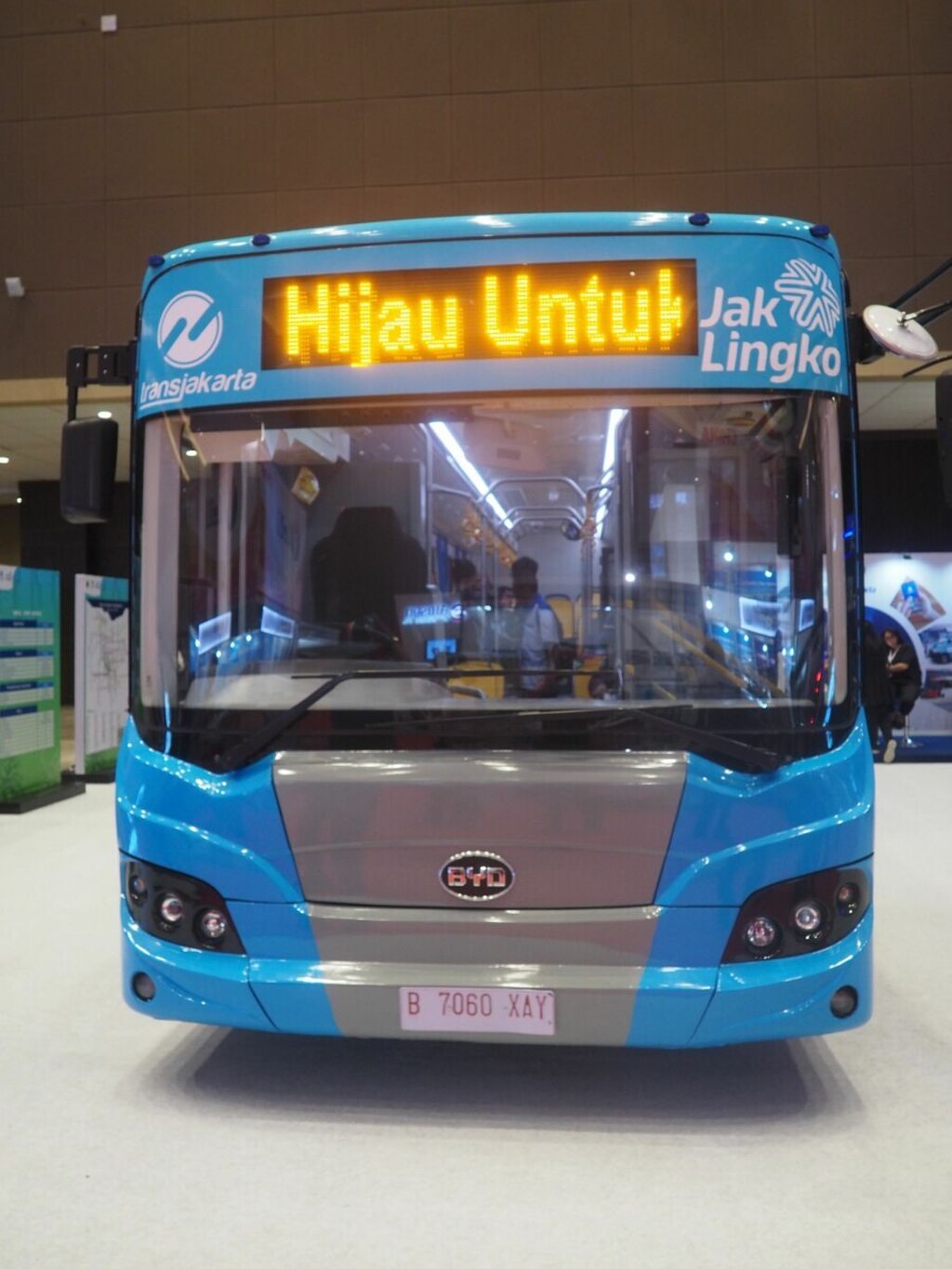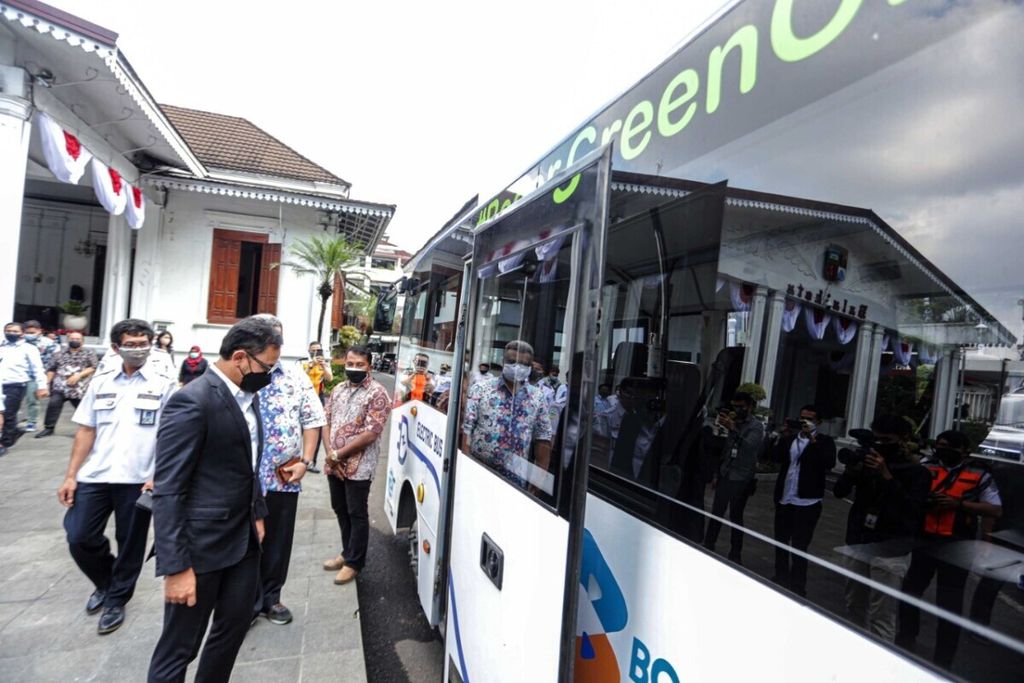Initial Investment Hampers Electric Buses
This will be the beginning of the Transportation Ministry’s policy with its target of making 90 percent of public transportation fleets in Indonesia battery-based by 2030.
/https%3A%2F%2Fasset.kgnewsroom.com%2Fphoto%2Fpre%2F2022%2F06%2F09%2F3f3cb91c-7e67-48fa-85d2-a47821c3c76e_jpg.jpg)
PT Powerindo Prima Engineering Manager Perks Darmster F Yimmy R shows how to charge electric buses operated by Mayasari Bakti at the Mayasari Bakti electric bus depot, on Thursday (9/6/2022).
The expensive initial investment in the electric bus industrial development poses a constraint on the program for mass transport electrification. Bus operators have a higher cost than conventional buses.
JAKARTA, KOMPAS — The use of electric buses as a means of mass public transportation is part of the government's ambition to transition to electric vehicles. However, there is the challenge of a costly initial investment for the purchase of vehicles.
Several policies have been adopted to start the operation of electric buses in Indonesia. For instance, the central government plans to operate 30 electric buses produced by PT INKA for the Group of 20 Summit Conference in Bali on Nov. 15-16.
After the summit is over, the 30 units named Merah Putih Buses will be sent to Surabaya and Bandung to become city bus fleets under the buy-the-service scheme along with 24 additional electric buses.
This will be the beginning of the Transportation Ministry’s policy with its target of making 90 percent of public transportation fleets in Indonesia battery-based by 2030.
The Jakarta provincial government has also begun its electric bus operation. At present, PT Mayasari Bakti as one of the operators of TransJakarta, operates 30 electric buses. The buses have served passengers in two corridors since Jun. 7.
Operational cost efficiency and freedom from fuel price fluctuation become the advantage of the electric bus operation. But a Kompas analysis showed that the high price of electric buses will likely be a constraint on authorities planning to realize the electrification of their bus fleets.
By calculating the feasibility of electric buses as public transportation fleets, the operational cost of electric buses almost equals the economic level offered by the existing fleets of fuel-based buses.
By using the BYD K9 electric bus sample operated by Mayasari Bakti for several TransJakarta routes, the total investment cost of electric buses for one service route for 10 years, which is the buy-the-service contract’s duration, amounts to Rp 93.5 billion (US$6.1 million).
This total is Rp 10 billion higher than the simulation of the total investment cost of Scania K250UB diesel bus operation, which is estimated at Rp 83 billion.
The distance covered by buses in a day is 225 kilometers on a route of 32 km.
This calculation scenario applies several assumptions, including the simulation of the route that needs 16 buses operating from 5 a.m. to 10 p.m. The distance covered by buses in a day is 225 kilometers on a route of 32 km.
In detail, the cost of purchase of one unit and 10-year operation of BYD K9 electric buses reaches Rp 5.85 billion. For Scania K250UB diesel buses, the cost is Rp 5.2 billion.
Big at the start
Further examination indicates significant differences in the cost structure. The use of electric buses needs a far bigger initial investment than that of diesel buses. It is because the price of electric buses may double that of diesel buses.
According to the e-catalog of the Government Goods/Services Procurement Policy Institute (LKPP), a Scania K250UB bus costs Rp 2.4 billion. Meanwhile, as reported by TransJakarta, the price of a BYD K9 reaches Rp 5 billion.

Illustration: an electric bus is ready to be tested. in the Jakarta area.
The expensive initial investment is later covered by the far lower operational cost of electric buses than that of diesel buses.
The energy cost of one electric bus per day is Rp 232,000 or around a third of that of a diesel bus, which can reach Rp 765,000. It is because the rate of electricity is far lower than the price of diesel oil.
At the electricity rate of Rp 796 per kilowatt-hour (kW-h), the travel cost of an electric bus amounts to Rp 1,032 per km. On the other hand, a diesel bus has an energy cost of Rp 3,400 per km.
Medium buses
In the meantime, the operational cost of INKA’s Merah Putih electric buses is higher than that of medium diesel buses of the same class, Hino FB 130, with the assumption of a daily coverage of 150 km.
One electric bus with a capacity of 20 seats has an initial investment and 10-year operational cost that can total Rp 3.87 billion. This amount is 76.9 percent higher than the initial capital and operational cost of a diesel bus that is around Rp 2.8 billion.
Also read:
> More Wasteful with Electric Cars
> Momentum of Electric Vehicle Development
The energy cost of INKA’s electric buses that is even more efficient than that of BYD electric buses, which is Rp 687 per km, is incapable of compensating for the initial capital for the procurement of electric buses that are far costlier than Hino diesel buses. INKA’s Merah Putih buses are sold at Rp 3.5 billion or almost 3.7 times higher than the price of Hino buses of Rp 950 million based on the LKPP’s e-catalogue.
Project manager of PT INKA, Edi Winarno, admitted that the initial capital to operate electric buses was still comparatively high. Nonetheless, Edi was convinced that it would be affordable. “But later, when they enter mass production, it will be lower,” he said.
Besides the high initial capital for the purchase of buses, the use of electric buses also requires a big investment in infrastructure, because it is necessary to build a large number of charging stations.
With support, the level of domestic components can be higher and the prices of buses will be lower.
Director of PT TransJakarta, Mochamad Yana Aditya, acknowledged that the price of electric buses was high. For this reason, they should be supported by the domestic electric bus component industry. With support, the level of domestic components can be higher and the prices of buses will be lower.
Operational director of PT Mayasari Bakti, Akhmad Zulkifli, said the energy cost of electric buses was lower than that of diesel buses. But the purchase price of electric buses is far higher than that of diesel buses. “So, as we are all studying this, we can’t say yet whether electric buses are better,” said Akhmad.
The operation of electric buses also needs a large initial investment. Akhmad revealed that Mayasari owns 10 battery charging dispensers for 27 of the 30 BYD K9 buses operated. The ratio of charging dispensers (SPKLU) is 1 to 3 or one dispenser is expected to serve 3 buses.
Apart from that, the cost of SPKLU construction is not small either. “It ranges from Rp 9 billion to Rp 10 billion for 10 units, each costing Rp 1 billion,” said Zulkifli.
Electrification
Corporate secretary division chief of TransJakarta, Anang Rizkani Noor, said TransJakarta would not only replace fossil-fuel buses with electric buses, but would also increase the number of vehicles to serve users of Jakarta’s public transportation.
In 2030, the entire fleet of TransJakarta will reach the target of being electricity-based. “Today our fleet has around 4,000 buses. In 2030, the total will be 10,000 and all are electricity [based],” said Anang.
Advocacy and social affairs chairman of the Indonesian Transportation Society (MTI), Djoko Setijowarno, mentioned the positive side of public transportation bus electrification, by which buses emit no gas so that the urban air is cleaner.

The Bogor City Government received an electric bus from PT Bakrie Autoparts, on Wednesday (4/8/2021).
Djoko hoped the electrification program launched by the central government and Jakarta provincial government can encourage residents to use public transportation.
He expressed fear that the big initial investment in fleet electrification may be unable to boost the interest of residents to use public transportation and will further increase the government’s burden.
“This should be considered. It will be useless if the program fails to shift people to use public transportation,” said Djoko. (XNA/SPW/PUT)
(This article was translated by Aris Prawira)